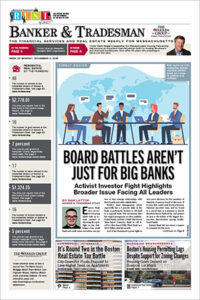As the calendar turns to 2025, banks will continue to receive little relief when it comes to interest rates.
The Federal Reserve has indicated that it expects to make only two interest rate cuts in 2025. Chair Jerome Powell has expressed that The Fed will be cautious in 2025 as the nation still deals with inflation.
“In some ways it’s surprising, in some ways it’s just more of the same,” said Dan Carey, senior vice president and CFO at Cambridge Savings Bank. “We don’t really know where things are going. We had a lot of election uncertainty, before that was economic uncertainty. There’s always something that we’re trying to grasp at.”
Credit Risk Still a Concern
Carey considers the Fed’s position in 2025 may be a response to the political atmosphere.
“It seems like compared to 2016 they’re moving much faster as far as getting people in place,” he said. “This is also [President-elect Donald] Trump’s second term, so he’s not going for reelection anymore. You kind of feel like he’s going to do what he wants to do and push forward. So you’re going to have some forces that obviously go against that, and I think that was the message that the Fed had.”
Reading Cooperative president and CEO Julie Thurlow also noted that from a budget standpoint, the bank isn’t counting on any rate decreases next year, partly due to the state of the economy and the new administration.
“That’s more our own self-reflection on the state of the economy, where it is right now, and the new administration and their appetite for tax reductions, for tariffs, just the conversation that’s being had in those topics could have an inflationary effect,” she said.
Credit risk is also still a concern, as assets are not repricing. Any reduction in rates will help reduce the cost of borrowing.
“The lower the reduction in rates means that the cost of borrowing won’t go up as much as it would have last year for some of the commercial borrowers who will be repricing in 2025 or 2026, but that’s probably a good thing, because that means that hopefully the inflation in the rental cost markets will be able to fund the increased cost of debt,” Thurlow said.
2024 Cuts Helped – But Not Much
Incremental rate cuts from the Fed at the end of 2024 didn’t do much to move the needle, said Brian Canina, president and COO of PeoplesBank.
“There is still significant pressure because deposit rates are still pretty close to what you could charge for, say, a 30-year mortgage,” Canina said. “There’s probably only about two to two-and-a-half percent spread between where you would see a high yield saving in a 30-year mortgage.”
Community banks, however, have seen an improvement in operations from rate cuts, Thurlow said.
“We now have a positively sloped yield curve,” she said. “It’s not super-positively sloped, but it is positive. So the last couple of rate reductions have resulted in an increase in the long end of the curve. That’s basically where community banks live and die.”
Carey argues that though current rates won’t provide relief for bankers and consumers, it is a positive shift towards the historical banking climate.
“In some ways it’s a positive thing,” he said of current rate conditions. “It should be set up like that. That’s how our economy is set up. The longer-term rate should be higher than shorter term, and it hasn't been like that for a long time, so we’re shifting the dynamics back to what we have always historically had.”
The Cambridge Savings Bank senior vice president added that while a 20- to 30-basis-point rate cut on deposits can mean a lot for a bank, consumers might not view it as a big enough difference. Still, consumers will have to adjust their thinking when it comes to what their money can earn and what banks can offer them.
“We have seen a lot of the digital rates start to come down,” he said. “People are really looking for apps, tools, things that make it easy to move around money.”

The yield curve may now have a slight positive slope to it, but banks will still face serious pressures in generating profits, experts say. But commercial real estate loan demand may yet improve. iStock illustration
Market Movement
The reduction in rates has similarly not been felt in the real estate capital markets. While the Fed’s interest rates hold weight in lending, the 10-year Treasury rate holds more, and it has been steadily climbing since 2020. The 10-year-Treasury was 0.93 percent on Dec. 28, 2020; as of this writing it is 4.62 percent.
This has put a damper on how much developers and investors have been turning to banks seeking loans.
“The Fed can control the short-term aspect with the Fed funds rate,” said Aaron Jodka, director of national capital markets research at Colliers. “The Fed rate cuts haven’t made a huge dent on borrowing costs for commercial real estate developers. Much of their debt is priced on the 10-year Treasury, or spread to that 10-year Treasury, so as of right now the Fed cuts haven’t meaningfully changed borrowing costs for commercial real estate.”
But Jodka believes that 2025 should see improvement in the industry.
“Sales should be improving for 2025,” he said. “You have a number of factors, including pent-up seller demand in the sense of funds have been extended, and at some point they will disperse of assets. There’s continuing to be fundraising. It’s not the rate of the past few years, but fundraising is still taking place, particularly in the core strategy.”

Sam Minton
Carey has also been pleased with what CSB has been able to do in the C&I and commercial real estate lending markets.
“It’s definitely a very competitive landscape, but we’ve had really great traction throughout the past couple of years, really, 10 to 15 years in that area,” he said. “Commercial customers in general are very cognizant that when you’re dealing with a business, they’re trying to make money as well. They understand where rates are.”
There is a fine balance between understanding that banks are a business and commercial customers wanting to look out for their best interests. Still, Carey is bullish on the market in 2025.
“We’ve seen a little bit of market movement, especially in commercial real estate, where assets are starting to trade again,” he said. “That can be institutional money that comes in from outside that helps, maybe a customer that’s located somewhere around where we are, so that can be a positive thing, but as far as the pricing goes, they’ve been pretty understanding.”







